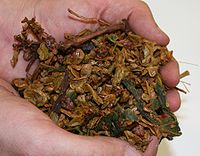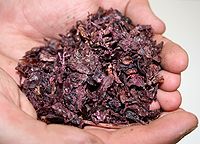- Pomace
-
Pomace (
 /ˈpʌməs/ pum-əs), or marc (/ˈmɑrk/; from French marc [maʀ]), is the solid remains of grapes, olives, or other fruit after pressing for juice or oil. It contains the skins, pulp, seeds, and stems of the fruit.
/ˈpʌməs/ pum-əs), or marc (/ˈmɑrk/; from French marc [maʀ]), is the solid remains of grapes, olives, or other fruit after pressing for juice or oil. It contains the skins, pulp, seeds, and stems of the fruit.Grape pomace has traditionally been used to produce pomace brandy (such as grappa or zivania) and grape seed oil. Today, it is mostly used as fodder or fertilizer.
Contents
History
“Pomace” is derived from the Latin “pomum” (fruit and fruit tree).[1] The English were the first to use the term “pomace” to refer to the byproduct of cider production.[2]
In the Middle Ages, pomace wine with a low alcohol content of three or four percent was widely available. This faux wine was made by adding water to pomace and then fermenting it. Generally, medieval wines were not fermented to dryness; consequently the pomace would retain some residual sugar after fermenting.
Piquette
The Ancient Greeks and Romans used pomace to create a wine that later became known as piquette. This was an inferior wine that was normally given to slaves and common workers.
After the wine grapes had been pressed twice, the pomace was soaked in water for a day and pressed for a third time. The resulting liquid was mixed with more water to produce a thin, weak wine.[3]
Uses
Apple pomace is often used to produce pectin and can be used to make ciderkin, a weak cider.
Grape pomace is used to produce pomace brandy and piquette. Most wine-producing cultures began making some type of pomace brandy after the principles of distillation were understood.
Winemaking
Pomace in winemaking differs, depending upon whether white wine or red wine is being produced.
In red wine production, pomace is produced after the free run juice (the juice created before pressing by the weight of gravity) is poured off, leaving behind dark blackish-red debris consisting of grape skins, stems. The color of red wine is derived from skin contact during the maceration period, which sometimes includes partial fermentation. The resulting pomace is more alcoholic and tannic than pomace produced from white wine production.
In white wine production, grapes are quickly pressed after crushing to avoid skin contact with pomace as a byproduct of the pressing. The resulting debris is a pale, greenish-brown color and contains more residual sugars than it contains tannins and alcohol. This is the pomace normally used in brandy production.[2]
Other uses
Pomace is produced in large quantities in wine production, with disposal an important environmental consideration. Some wineries reuse the material as fertilizer, while others are exploring options such as selling it to biogas companies for renewable energy. As envisioned, pomace would be introduced into anaerobic digesters that contain microorganisms that aid in its decomposition and produce methane gas that could be combusted to generate power.[4]
Studies have also shown that specific polyphenols in red wine pomace may be beneficial for dental hygiene. A study conducted at the Eastman Dental Center found that these polyphenols interfere with Streptococcus mutans, the bacteria in the mouth that causes tooth decay. Professor Hyun Koo, the lead researcher of the study, hopes to isolate these polyphenols to produce new mouthwashes that will help protect against cavities.[5]
A 2004 study conducted by Erciyes University in Turkey found that pomace can also act as a natural food preservative that interferes with E. coli, Salmonella and Staphylococcus bacteria. Researchers used the dried pomace from the white Turkish wine grape Emir Karasi and red Kalecik Karasi to produce a powder that was mixed with ethyl acetate, methanol or water and exposed to 14 different types of food bacteria. The results showed that all 14 bacteria were inhibited to some degree by the pomace—depending on the grape variety and the concentration of the extract. The red wine grape Kalecik Karasi was shown to be the most effective; the study researchers believed this was due to the higher concentration of polyphenols in red wine grape skins.[6]
Oenocyanin, a natural red dye and food-coloring agent, is produced from grape pomace. Some companies also recover tartrates (potassium bitartrate, 'cream of tartar') and grape polyphenols from grape pomace.[2]
See also
References
- ^ Cfr. Latin dictionaries. V.gr. “Diccionario ilustrado latino-español”, Editorial de las publicaciones Spes y Vox. 6ª ed. , Barcelona, 1969 ad voces “pomum” and “malum”
- ^ a b c Robinson, Jancis (ed.) (2006). The Oxford Companion to Wine (Third ed.). Oxford: Oxford University Press. pp. 534–535. ISBN 0198609906.
- ^ Robinson, Jancis (ed.). The Oxford Companion to Wine (Third ed.). p. 532.
- ^ "GrapeVine". Wine Spectator: 16. Jan. 31–Feb. 29, 2008. http://www.winespectator.com/magazine/show/id/12391.
- ^ "Red-wine waste can check cavities". The Times of India. Asian News International. January 3, 2008. http://timesofindia.indiatimes.com/Red-wine_waste_can_check_cavities/articleshow/2671985.cms.
- ^ Gaffney, Jacob (September 23, 2004). "What a Waste! Grape Pomace Kills Food-Spoiling Bacteria". Wine Spectator. http://www.winespectator.com/webfeature/show/id/What-a-Waste-Grape-Pomace-Kills-Food-Spoiling-Bacteria_3402.
Further reading
- Crowe, Alison (Aug/Sept 2005). "The Pomace Predicament". WineMaker. http://winemakermag.com/component/resource/article/678-the-pomace-predicament.
- Hang, Y. D.; Woodams, E. E. (April 1985). "Grape pomace: A novel substrate for microbial production of citric acid". Biotechnology Letters 7 (4): 253–254. doi:10.1007/BF01042372. http://www.springerlink.com/content/g7785035888q5r8n/.
Categories:
Wikimedia Foundation. 2010.



